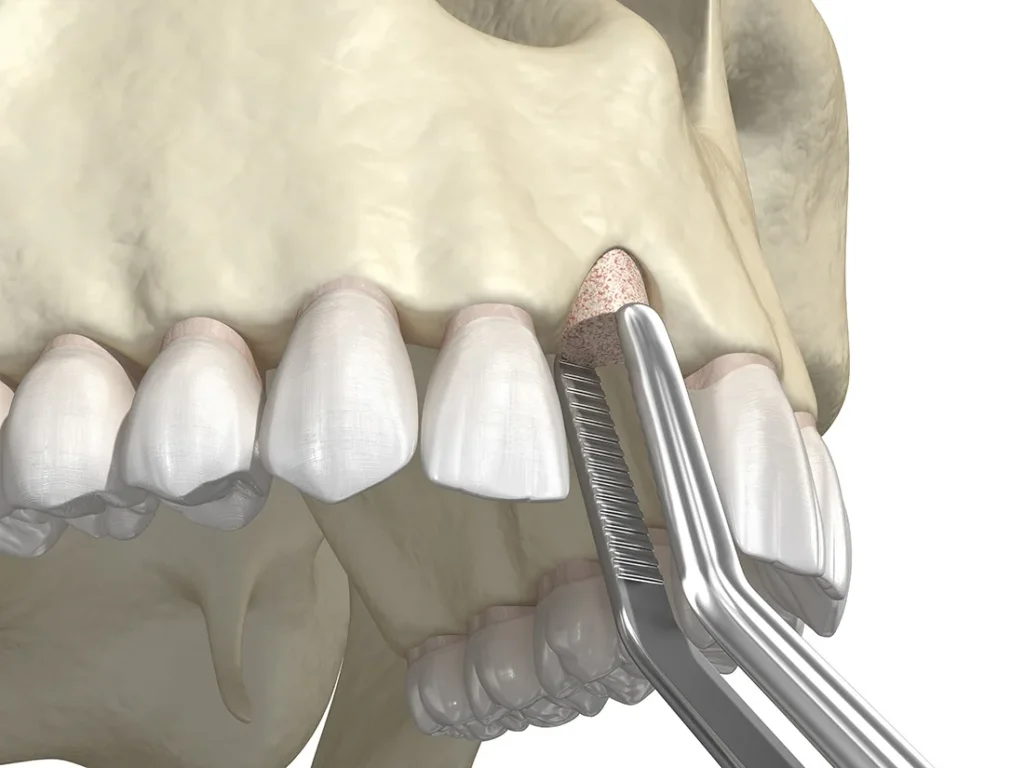
When tooth loss occurs, the underlying bone that once supported your teeth begins to deteriorate, creating challenges for future dental restoration options. This process, known as bone resorption, can greatly impact your oral health and limit your ability to receive treatments like dental implants that require adequate bone structure for successful placement.
At Naylor Family Dental and Implant Center, Dr. Brian Naylor understands that bone grafting plays a crucial role in restoring your oral foundation and expanding your treatment possibilities. Our Las Vegas practice combines advanced techniques with compassionate care to help patients rebuild the bone structure necessary for long-lasting dental restorations and optimal oral health. If you’re considering dental implants or have been told you need additional bone support for treatment, understanding your bone grafting options can help you make informed decisions about your dental care.
Bone grafting is a surgical procedure that reconstructs or augments areas of the jaw where bone has been lost due to tooth extraction, gum disease, or injury. During this treatment, bone material is placed in the affected area to encourage fresh bone growth and build a stable foundation for future dental work.
The bone material used in grafting can come from several sources. Autografts use bone from your own body, typically harvested from another area of your jaw or hip. Allografts utilize processed bone from a donor source, while xenografts use bone material from animal sources, usually bovine. Synthetic bone substitutes offer another option, providing a framework for your natural bone to grow around.
Your Las Vegas bone grafting procedure will be customized based on your specific needs, the location of the graft site, and your overall treatment goals. Dr. Naylor will evaluate your case thoroughly to determine the most appropriate grafting material and technique for optimal results.
Several situations may require bone grafting to restore adequate bone volume for dental treatments. Tooth extractions often leave behind spaces where bone begins to shrink immediately after the procedure. Without intervention, this bone loss can make future implant placement challenging or impossible.
Periodontal disease represents another common reason for bone grafting needs. Advanced gum disease destroys the bone that supports your teeth, creating pockets and instability. Even after treating the infection, bone grafting may be required to restore the supportive structures around your remaining teeth.
Trauma from accidents or injuries can also damage the bone, requiring grafting to repair the affected areas. Additionally, some patients have naturally thin bone structure or have experienced significant bone loss over time, making grafting necessary before proceeding with implant preparation.
Your bone grafting journey begins with a comprehensive evaluation of your oral health and bone structure. Dr. Naylor will use advanced imaging technology to assess the quantity and quality of your existing bone, helping determine the extent of grafting needed for your specific situation.
On the day of your procedure, local anesthesia ensures your comfort throughout the treatment. The graft site is carefully prepared, and the bone material is placed precisely where new bone growth is needed. In many cases, a protective membrane covers the graft to promote healing and prevent soft tissue from interfering with bone regeneration.
The healing process typically takes several months as your body integrates the graft material and generates new bone tissue. During this time, you’ll follow specific post-operative instructions to promote optimal healing. Ridge augmentation procedures may also be recommended to enhance the contours of your jaw for the best functional and aesthetic outcomes.
Regular follow-up appointments allow Dr. Naylor to monitor your healing progress and determine when the grafted area has developed sufficient bone density for your next phase of treatment.
Successful bone grafting opens doors to treatment options that may not have been possible without adequate bone support. Most importantly, proper bone foundation dramatically improves the success rate and longevity of dental implants, allowing you to replace missing teeth with stable, permanent solutions.
Beyond implant placement, bone grafting helps maintain your facial structure and prevents the sunken appearance that often develops after tooth loss. Within the first three months of tooth loss, you can lose up to 25% of the bone in that area, making early intervention valuable for preserving your natural facial contours.
Bone grafting also provides stability for other dental restorations. Whether you’re considering dental bridges or need additional support for existing teeth, adequate bone structure improves the long-term success of various treatment options.
The procedure can also address functional concerns, improving your ability to chew effectively and speak clearly. When bone loss has affected multiple areas of your mouth, grafting as part of full mouth rehabilitation can restore both function and aesthetics comprehensively.
Bone grafting represents an important investment in your long-term oral health, providing the foundation necessary for successful dental restorations and maintaining your quality of life. At Naylor Family Dental and Implant Center, we understand that each patient’s situation is unique, and Dr. Naylor takes time to explain your options and develop a treatment plan tailored to your specific needs and goals.
Our Las Vegas practice combines advanced surgical techniques with a commitment to patient comfort, ensuring you receive the highest quality care throughout your bone grafting journey. Dr. Naylor, who completed his dental education at Indiana University in 2017, brings years of experience to every procedure, helping patients achieve the stable oral foundation they need for lasting dental health. Take advantage of our $300 new patient special, which includes a thorough cleaning, comprehensive exam, and x-rays. Contact our office at (702) 395-0366 or request an appointment online to discuss how bone grafting can support your dental treatment goals.
Modern bone grafting was first developed in Germany in the early 1820s.